Supervision Bible

Costume Supervisor Bible: The Wolves of Willoughby Chase
Costume Designer:Isobel Kantaris
Costume Supervisor: Rachel Lacey
Assistant Costume Supervisor: Rosie Maddox
Head of Running Wardrobe: Amelia Bavin
Table of Contents
Table of Contents
Bonnie Character Page
Bonnie Measurements
Bonnie
Sylvia
Sylvia
Bonnie
Bonnie
Sylvia
Sylvia
Sylvia
Sylvia
Bonie
Sylvia
Table of Contents
Train
Train
Mr
Mr
Mr
Mr
Mr
Mr
Table of Contents
Cast List
Wolves of Willoughby Chase

In order of Appearance











Fitting Schedules
F r i d a y 2 0 t h O c t o b e r , F i r s t F i t t i n g
F r i d a y 1 7 t h N o v e m b e r , T h i r d F i t t i n g


Tech Schedules


*Tech schedule made by Ben Goodridge
Script Breakdown

Script Breakdown

Script Breakdown




Rehearsal Report


Rehearsal Report
Written by Lucy Rush Deputy Stage Manager
Rehearsal Report
Written by Lucy Rush Deputy Stage Manager
28/11/23

*Only rehearsal notes that mention costume have been put into costume bible

Show Report
Written by Lucy Rush Deputy Stage Manager

Show Report
Written by Lucy Rush Deputy Stage Manager

Show Report
Written by Lucy Rush Deputy Stage Manager

Show Report
Written by Lucy Rush Deputy Stage Manager
Technical Rehearsal Notes

Technical Rehearsal Notes

Dress Rehearsal Notes

Research

Child Labour
Contextual Research
In 1830, George Stephenson invented the world's first public inter-city rail line connecting Manchester and Liverpool, which revolutionised transportation between the UK's industrial powerhouses. Cotton was sourced from American plantations across seas and transported to Manchester textile mills where it was transformed into fabric The fabric was then transported to Liverpool for export to the rest of Britain This was a significant development for the textile industry, as it not only made textiles more accessible across Britain but also accelerated the production process.
In 1833, the Factory Act was passed by Parliament to prohibit children under the age of 9 from working in the textile industry, a year after the setting of The Wolves of Willoughby Chase In Wolves, characters Bonnie and Sylvia both get sent to Brisket Blastburn Academy for Girls which is a workhouse disguised as a school/ orphanage for girls.
King William IV
King William IV reigned as the king of England from 1830 to 1837 He was an unexpected monarch as he was the youngest of three. His father, King George II, had reigned for 60 years King William IV was a popular king and was known for being friendly and relatable as he often mingled with the public.
King William IV's reign paved the way for political and social reforms of the Victorian era During his reign, he introduced the Reform Act of 1832. This act expanded social rights and reduced corruption in elections. Additionally, he abolished slavery in the British Empire and introduced a modern police force that was continued by his brother's reign.

King George IV

King George IV was the King of England from 1820 to 1830. He was the elder brother of William IV and ruled during the Regency era. During the 1820s and 1830s, George IV had a significant impact on fashion, as he followed the popular dandy style This style was influenced by his close friendships with Regency fashion icons like Beau Brummell. He was known for his elegance and would often wear elaborate coats, waistcoats, and hats. However, in his later years, he developed a fondness for food, which caused him to gain weight. To hide his weight, he had to wear a whalebone corset and girdle
Research
Fig 4
The Wolves of Willoughby Chase 1989
I watched the movie The Wolves of Willoughby Chase from 1889 The movie is fairly similar to the script by Joan Aiken adapted by Russ Tunney, which I read for research.

The Wolves of Willoughby Chase 1889
Above are photos from The Wolves of Willoughby Chase 1889 Figure 1 shows (starting from the left) James, Mr Grimshaw, Sylvia, Miss Slighcarp and Bonnie
James
The novel "Wolves of Willoughby Chase" is set in an alternate world in 1832, where King James III ruled.
During his reign, the channel tunnels throughout Europe were opened, leading to an overpopulation of wolves from cold countries in Europe migrating to Britain.
The story revolves around Bonnie and Sylvia, who are nineyear-old cousins. At the beginning of the story, Bonnie's mother becomes sick, and her parents leave to seek the healing sea air During their absence, her father enlists the help of Miss Slighcarp, a governess who turns out to be a horrible person Miss Slighcarp plans to sink Mr and Mrs Willoughby’s ship to rewrite their will and steal their fortunes. She also plans to send Bonnie and Sylvia to a workhouse-style orphan school
However, there are some characters who help Bonnie and Sylvia to defeat the villainous Slighcarp and overcome the obstacles in their way
James is Mr and Mrs Willoughby’s beloved butler, in the image above, James is wearing a red frock coat with gold embellishments and trims, a red waistcoat with gold trim, red breeches, and white knee-high stockings. However, his outfit is not historically accurate as it does not represent the clothing typically worn by servants/butlers in the 1830s Servants/butlers would wear darker frock coats and trousers, which would match the clothing worn by their masters.
Mr Grimshaw
Mr Grimshaw is a friend of Miss Slighcarps who follows her twisted ways to try and gain the Willioughby’s fortunes In Figure 1, Mr Grimshaw can be seen wearing a white shirt with a high-collar, paired with a loose necktie He is also wearing a red waistcoat, a burgundy frock coat with a wide black velvet collar and pocket flaps, and brown checkered trousers. Although Grimshaw's attire depicts a historical representation of the 1830s, there is still a modern aspect to it, which could be due to the fantasy twist in the movie.
Miss Slighcarp

Fig 5
Miss Slighcarp is a frightful and selfish character portrayed in the movie The character has various noticeable costume changes throughout the film. However, due to its age, which is over 30 years old, there are limited photos available for reference, and the camera quality within the movie is not sufficient for analysing the details of the costumes
In the images above Slighcarp is wearing a black silk dress, with a black bow on the centre front neckline, it also has legs of mutton sleeves, which relate to fashions from the 1830s The dress has a high waistline which has a thick belt worn over it. This dress silhouette is very similar to the dress from the Wolves of Willoughby Chase AUB production
Research

Sylvia
The character Sylvia, who is timid and innocent, is around 9 years old and happens to be Bonnie's cousin
In the image above she is wearing a dress, which is almost identical to Bonnies in shape, although it has a slightly wider neckline and is shorter at the hem
Miss Slighcarp
Slighcarp is pictured on the left wearing a dress similar in shape to her previous outfit, but with more exaggerated sleeves and skirt, emphasizing her evil character The dress is made of dark red satin, with a green thick waistband and a white shawl/scarf. Although the neckline of the dress doesn't conform to the fashion of the 1830s, the rest of the dress is an exaggerated version of 1830s fashion
Bonnie
is one of the main characters in the story who is a nine-year-old girl with a short temper but a kind heart In the picture on the left, she is seen wearing a green and red checkered dress that resembles Miss Slighcarp's dress, but with less exaggerated shaping The dress focuses more on the 1830s fashion trend. She wears a thick belt on a higher waistband, which was a key fashion trend during that era
Additionally, she has leg-of-mutton sleeves, which was also a significant fashion trend at that time. Beneath her dress, she wears pantalettes, which was common for children to wear under their dresses, and they would show below the hemline.

Bonnie and Sylvia
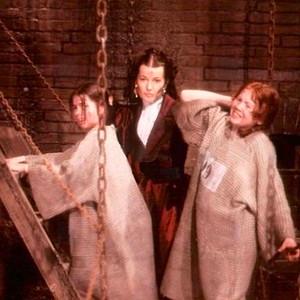
The two girls are wearing cloaks to keep themselves warm while they are outside in the snow. During the 1830s, cloaks were commonly worn by both men and women In this particular image, Bonnie has a green cloak while Sylvia is wearing a red one Interestingly, these two cloaks bear a striking resemblance to the ones used in the Wolves of Willoughby Chase production at Arts University Bournemouth, but with different colours - Bonnie wears red and Sylvia wears blue
In the movie, during the orphan scene, the girls are seen wearing long-sleeved and long-hemmed loose-fit outfits, with the numbers 98 and 99 printed on the front The reason behind the numbers is that during this part of the movie, the girls are portrayed as orphans who work all day at a school They are not given any names and are only identified by their respective numbers. In the 1830s, orphans would generally wear clothes made out of scrap fabrics or handed down, which would not have much shape or aesthetic appeal to them
Research
Interview with Ginny Graham Costume Assistant on Wolves of Willoughby Chase 1989
Question
What was your role whilst working on Wolves of Willoughby Chase?
How long did you work on this project for roughly?
Answer
I was a costume assistant that helped with alterations, dressing and laundry It was quite a small company
I worked on the film for the entirety of the film shoot
What would your daily job entail?
Were the costumes made specifically for the film? If so what was the process (were they made by a making team months before)
I would ch for any alt press the the actors day woul there was’


Most of th made mo separate t pieces we howev costumes were designed fo the film and made by the costume departement I wa a slightly separate department to them
Were any costumes sourced/ Hired? If so where from?
It was such a long time ag now, I can’t really remembe

Do you usually work with historical costume, if so what’s your favourite part about it?
Yes, I worked in the industr for 25 years, but I’m retired now I loved working with historical costume as I love working with the history and detail that would go into the costumes I always found costuming for modern projects quite boring
*There aren’t a huge amount of pictures from the movie, the images are screenshotted from movie footage from the late 80s

Research
Question Answer
Was there a costume which was specifically difficult to work with?
Did you have a favourite costume from the movie?
Were there any challenges which came up whilst working on this project?
Do you usually work with historical costume, if so what’s your favourite part about it?
Stephanie Beacham’s (Miss Slighcarps) costumes had the most undergarments and layers to them making them quite heavy and difficult to lift up when dressing the actress She often complained about the costumes being too heavy, and her overheating so we had to fan her between the takes
The purple ball gown dress which Stephanie Beacham wore
As I said before the costumes had lots of layers and were very heavy It was quite difficult for the actors, with thick hot heavy layers
Yes, I worked in the industry for 25 years, but I’m retired now I loved working with historical costume as I love working with the history and detail that would go into the costumes. I always found costuming for modern projects quite boring


13
Ginny Graham worked as a costume assistant and designer for 20 years in theatre, TV and film. She is passionate about costumes and has dedicated her life to film and theatre
14
The images above shows Stephanie Beacham in her role as Miss Slighcarp, wearing a stunning purple ball gown dress She accessorized this outfit with a wolf scarf, similar to the one worn in the AUB production The dress features an exaggerated leg of mutton sleeves, a huge gathered skirt and a deep v-neckline. While the dress is inspired by the fashion of the 1830s, it has been enhanced to create a more dramatic effect
Research
1837 Day Dress shown in the Victorian and Albert Museum
Marianne Maurice was the owner of this day dress from 1837. Dresses in the 1830s were characterized by huge collapsed sleeves and wide pleated long skirts, which would be lined with flannel or muslin to hold their shape Day dresses were typically around an inch off the floor, while evening dresses were ankle-length At the start of the decade, day dresses featured higher necklines, while evening dresses had slightly lowered necklines As seen in the image, this particular dress has a slightly lowered neckline and gathered sleeves, which is consistent with the fashion trends of the later 1830s
Fig 14

Day
1837-1839 Dinner Dress.
This dress I saw this at Chertsey Museum and its an evening/dinner dress from the late 1830s During this period, dinner dresses were quite popular, having been introduced in the 1820s and gaining momentum into the 1830s The dress has a slightly off-the-shoulder bodice, which was fashionable at the time The bodice is piped, and the piping is visible down the center front. Trims played a significant role in the design of dresses during the 1830s, and this dress is no exception It has gold trims thatess, and they embellish the pleats of the skirt, mirroring the front of the cartridge pleated skirt.

Dress 1830s at the Victorian and Albert Museum
This dress and pelerine date back to the 1830s The dress is made of brown silk and features collapsed sleeves, a lowered neckline that slopes down into a V shape at the centre front, and a pleated skirt that hangs an inch off the floor. It has a pelerine over the top of it which was a popular accessory in the 1830s The character Mrs Willoughby is designed with a pelerine worn tucked into the bodice of her dress.

Research Chemises
17

During the 1830s, it was common for women to wear a chemise under their t ti l l d th th i t Th h i f




Children’s Undergarments
Petticoats

Children in the 1830s would wear similar clothing until they reached around the age of 6 Boys and girls would both wear pantalettes under their cotton or wool patterned dresses Pantalettes would be slightly longer than the hemline of childrens wear as the hemline began to rise.
During this period, women's skirts would typically be bell-shaped, with petticoats worn underneath to maintain the shape. There were several ways to make petticoats, such as by starching them to provide structure and stiffness or by sewing cording onto the hem up to the hip. The level of the petticoat would vary depending on the length of the overskirt
Bustles
Ruffle bustles were worn on top of the back of the petticoat to lift the shaping. During this period, bustles were typically thin, lightweight, and short. Mrs Brisket is the only female character who wears a bustle, however, they wear an 1880s shaped bustle due to their actor being male in drag, so an 1880s bustle would emphasise shape, especially on a male figure


In the 1830s, it was uncommon for most children to wear stays since it was believed to be unhealthy. However, there were still some traditional parents who insisted on their children wearing stays to help improve their posture and achieve a straight back.

Figure 1 shows a painting from the 1830s with a family in it. The younger children are wearing pantalettes under their dresses and the younger child on the right is wearing a pinafore over their dress to protect the material which was very popular in the 1830s. The older children in the picture are wearing similar garments which adults would wear so their undergarments would be similar to adults except they would not be wearing stays. Bonnie and Sylvia, who are both characters around 9 years old, wear bodices with boning but do not wear stays or corsets as part of their costumes They also wear breeches, which act as short pantalettes under their skirts To add structure to their top skirts, they also wear frilled petticoats.
Similar to the undergarments on the mannequin above from the Victorian and Albert, characters such as Mrs Willoughby and Miss Slighcarp wear chemises, corsets, and petticoats However, they do not wear traditional sleeve supports due to the costumes being worn in a show with lots of physical movement and quick changes Mrs Willoughby, Miss Slighcarp, and Mrs Brisket’s costumes are all reinforced with netting to hold the puffed balloon sleeve shape, typical of the 1830s fashion
Research

Alfred Guillaume Gabriel, also known as the "Prince of Dandies," introduced French style to British menswear when he relocated to London in 1830

1830 Mens Undergarments
1830 Menswear
In the early 19th century, men's fashion was primarily focused on impressing others. Clothing was designed predominantly for aesthetics rather than utility This trend continued until the 1830s when Balzac's essay "Traité de la Vie Elégante" was published. In the essay, he referred to those who followed dandyism as "extremely ingenious mannequins" However, dandyism remained popular through the decade
In the 1830s, men commonly wore Dress and Frock coats during the day
Characters like Mr Willoughby, James, the Train Conductor, and Dr Mourne all wear different variations of frock coats
Tailcoats were reserved for formal daytime events and evening wear, while great coats and cloaks were worn as outerwear during the day.
Great coats were long coats with wide sleeves, and Mr Grimshaw wears a green velvet great coat
Accompanied by waistcoats and shirts.
In the year 1820, full-length trousers were introduced in fashion, which were previously considered as working-class or work-wear garments. Before this, men would wear pantaloons, which were a slightly longer and tighter version of breeches. Pantaloons were a transition in men's fashion from breeches to trousers.
In the Wolves of Willoughby Chase, almost all characters except Mr. Grimshaw and female characters wear breeches, which is not historically accurate for the 1830s However, the show is based in a fantasy version of Britain where King James III is ruling, which would have a significant impact on fashion trends at the time as the monarchy was a major influence on fashion.


During this period, shirts were considered as undergarments Therefore, they were designed to be hidden under a waistcoat and cravat. These shirts were typically made from cotton or linen and had a high collar. The collar would be detachable and fastened with collar studs In the show, Mr Grimshaw wears a white cotton shirt with a detachable high collar, which accurately represents the typical shirt style of that period During the 1830s, men belonging to the upper class and fashion-conscious would wear discreet corsets as an undergarment to achieve a slim waistline However, male corsets are not used in the show due to the physical activity and quick changes required.
Research

1830 Accessories
In the past, men would wear an accessory around their neck, which was either a stock or a cravat.
Stocks
The photo on the left shows an 1830s stock, which is similar to the necktie designed for Mr Grimshaw in the AUB production of Wolves During the 1830s, stocks were typically made from materials such as velvet, silk, or satin, and they were stiffened to hold a solid shape, and the secured at the centre back
Cravat
Cravats were typically made of muslin or silk, crafted from a large piece of fabric that allowed them to be tied in various ways. A dandy style cravat would be wrapped around the neck and fastened with a decorative pin. The scarf cravat, on the other hand, would be wrapped around the neck and tied in a way that created a scarf-like shape at the front.

Shoes Womenswear
Women's shoes would be made out of silk or satin and have leather soles. They would be lightweight and fastened with lace ribbons which would tie up the leg

Shoes Menswear
These shoes, which are on display at the V&A, date back to the 1830s During this era, leather buckle shoes were a popular choice for men, but by the 1840s, they were no longer in fashion The shoes in the picture have served as an inspiration for the men's shoes in Wolves of Willoughby Chase Leather lace-up boots were also relevant during this era and many of the characters in the movie wear boots that resemble these. The male characters can be seen wearing leather buckle Darcy shoes, while the female actors portraying male roles opt for boots or lace-up boots


In the production, both Sylvia and Bonnie wear satin short-heeled shoes that feature an opening which fastens with a ribbon These shoes are reminiscent of the women's wear shoes from the 1830s, but with a modern twist to suit the fantasy aspect of the show











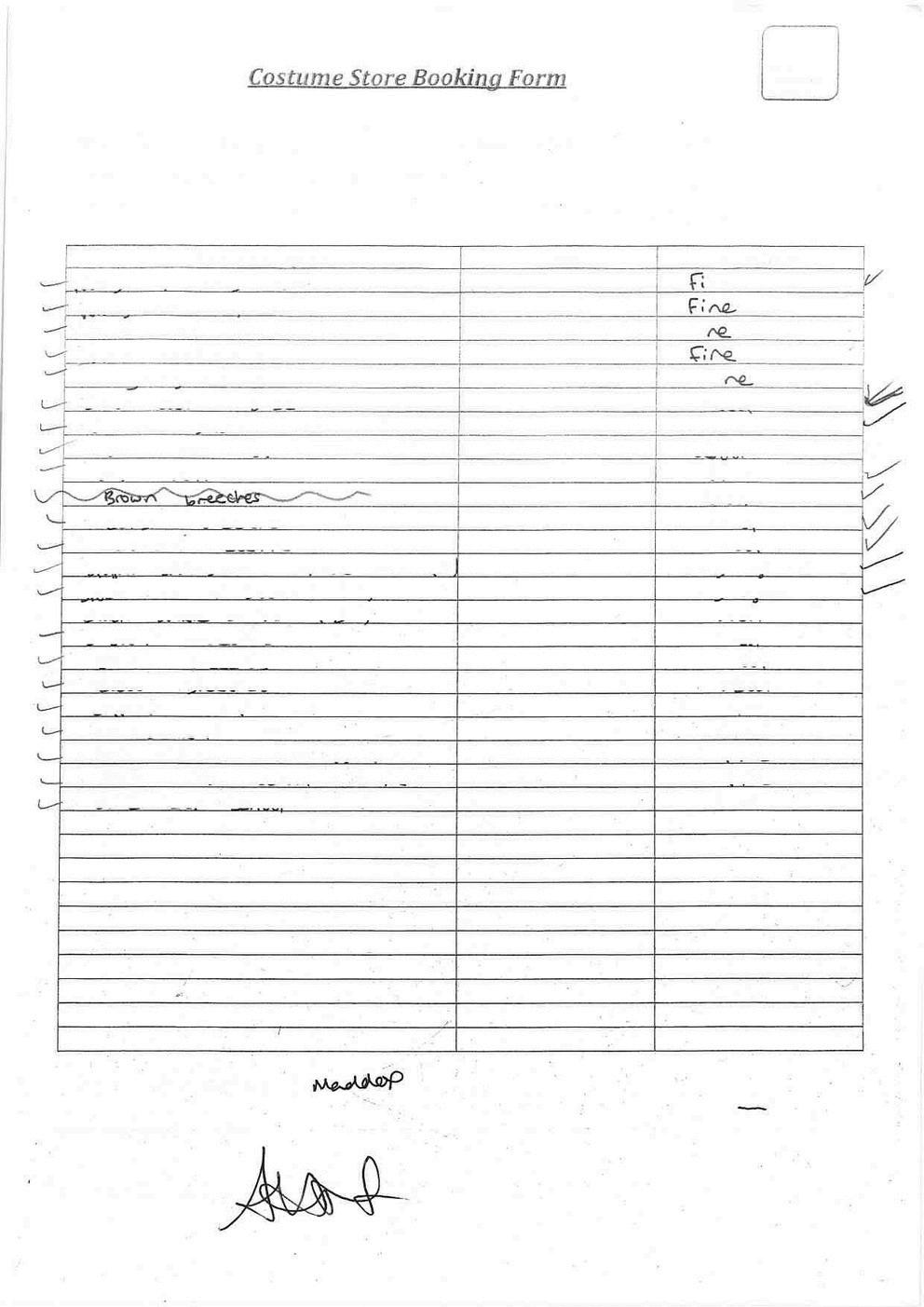





















Estimated Budget


Estimated Budget



Final Budget



Final Budget



Final Budget




Final Budget




Sustainability Statement

Sustainability Statement

Actor:Solo Candy Character:James
Measurement Sheet
Measurement Cheat Sheet
Costume Design
Fitting Photos
Fitting Notes
Make Breakdown
Costume Breakdown
Pictures From Measurements




Costume Design

1st Fitting Photos


1st Fitting Photos


1st Fitting Photos


1st Fitting Photos


1st Fitting Photos


1st Fitting Photos


1st Fitting Photos




1st Fitting Notes
Actor Solo Candy Character James Maker
Rebecca Li
Notes
Make breaches sit higher
Make breaches straighter (same width as the top of the breaches)
Gather the bottom of the breaches into the hem
Shirts are being dyed and eyelets covered
Insole or smaller shoes
Make cravat for second fitting
Move the arm hole to the pined line
Measure new arm hole
Make sleeve 3cm bigger
Have 3D cuff
The side seam of the cuff should slightly overlap the cuff decoration
Add braided trim around the centre front of the waist coat
Could dye the trim a red hue (Isabel needs to decide)
Use the bigger pocket
2nd Fitting Notes
Actor Solo Candy Character James Maker
Rebecca Li
Notes
Waistcoat:
• Braid around the edge of the pocket flap to stand out
• Braid around CF Breeches:
• Take in at CF and at waist Shirt:
• Keep same shirt, neckline will be covered by cravat. Cravat:
• Stand needs to be higher – 5cm neckband.
• Choose tiered sample – less frivolous.
• Make new cravat – long strip Jacket:
• Braid on pocket flaps and CF to add dimension.
• Braiding on cuff and collar too.
• Buttonholes: choose the dark one
• Collar: pointy at the CB to mirror the pocket flaps.
2nd Fitting Photos


2nd Fitting Photos


2nd Fitting Photos


2nd Fitting Photos


2nd Fitting Photos

2nd Fitting Photos




Preassessment Notes
Actor Solo Candy CharactJ ames Maker Rebecca Li Notes
Socks need to be longer
Dressing: cravat needs to be dressed to be wider
Coat:
- Take buttons off and replace with poppers, fake buttons with poppers underneath

- Open up CB by an inch up to nothing at the neck


Make Breakdown

Make Breakdown




Costume Breakdown

Actor: Solo Candy Character:Mr Wilderness
Measurement Sheet
Measurement Cheat Sheet
Costume Design
Fitting Photos
Fitting Notes
Costume Breakdown
Pictures From Measurements




Costume Design


1st Fitting Photos


1st Fitting Photos


1st Fitting Photos


1st Fitting Photos


1st Fitting Photos



1st Fitting Photos



1st Fitting Notes
Character
Mr Wilderness Maker Sourced
Actor Solo Candy Notes
• Size 12 combat boots
• Big heavy belt
• Take the trousers in as pleats at the side to create more volume
• Blue neckerchief with patches, wrapped twice and tied in knot
• Chunky knit socks
• Brown boots
• Woollen patterned scarf Jacket
• Change buttons for woven leather buttons
• Dye or paint the leather buttons a shade darker
• Raise the hem as pinned
• Leather or suede collar
• Leather patches
2nd Fitting Notes
Actor Solo Candy Character Maker Mr Sourced Wilderness Notes Breeches
• Tuck into socks
• Changes to James’ breeches
• Tartan blue socks Jacket
• Good Length
• Buttons good
• Take out M&S label
• Take bottom pockets off
• Distress with patches
• Potential change lining Waistcoat
• Patches taken off Accessories
• Bigger belt
• Hat is good
• Not sure about tie with stripes
2nd Fitting Photos


2nd Fitting Photos


Preassessment Notes
Mr Sourced Wilderness Notes • Need chunky socks



Pre-assessment Photos

Chorus


Pre-assessment Photos
Wolves/ Chorus




Costume Breakdown

Costume Breakdown



Costume Breakdown

Costume Breakdown


Actor: Lily Skegg Character: Bonnie
Measurement Sheet
Measurement Cheat Sheet
Costume Design
Fitting Photos
Fitting Notes
Make Breakdown
Costume Breakdown

Pictures From Measurements









1st Fitting Photos



1st Fitting Photos



1st Fitting Photos


1st Fitting Photos


1st Fitting Photos


1st Fitting Photos
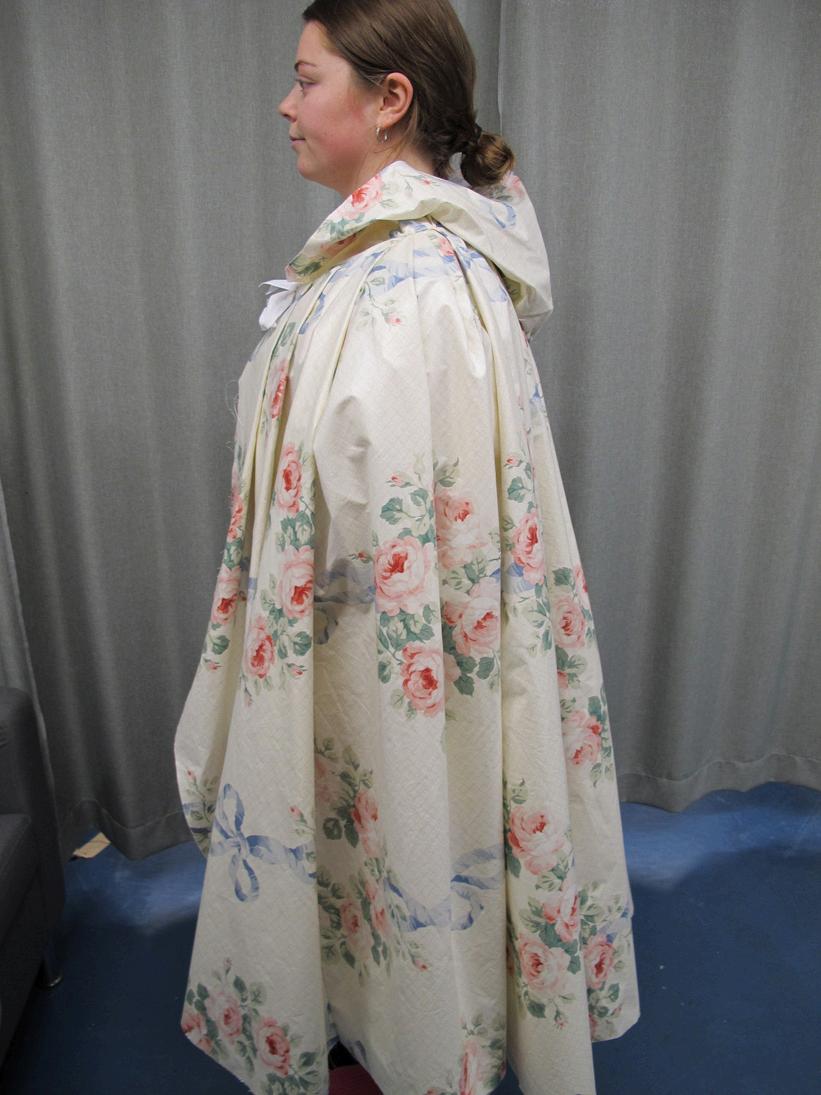

1st Fitting Photos




1st Fitting Notes
Actor Lily Skeggs Character Bonnie Maker Hannah Powells
Notes
Bloomers need to sit higher (Waist Hight)
Bloomers need to be taken in on the back by gathering
Bloomers need to be made 5cm bigger around the knee
Match the seam allowance on the shoulder seam
Sourced – Maybe a knitted Cardigan or school jacket for the boy costume (Isabel will think about it)
Leave bodice untucked for the boy costume
Make skirt tighter around the waist
Petticoat waist needs to be tightened
First row of frills starts at the bottom of the yoke on the petticoat
Make the skirt as long as the bottom of the seam allowance
The inner sleeve needs to be gathered and let out
Less gathering on the under side of the top sleeve
Less volume on the top sleeve
Change pleating on the top skirt to a box pleat
Add waistband
Bow on the back of the of the skirt (same fabric as skirt)
Cape will be lined
Change how the cape folds (follow twill)
Add arm holes to the cape
Make the cape smaller by the hood seam and get rid of excess fabric
Wear hood slightly back to show the actress’s face
The cape hem should be low at the back and curve upwards towards the front
2nd Fitting Notes
Actor Lily Skegg
Character
Bonnie Maker Hannah Powles
Notes
Bodice:
• Tension in seam allowance released at armholes Cut slightly bigger.
• Keep original hem design line.
• Query regarding whether the bodice will be tucked into the breeches, or over the top of the waistband.
• Bodice will be on top of the bodice, not tucked in
• White lace collar. NO red bow at CF.
• Add red trim to imitate piping
Use pink, floppy ribbon for bows – bodice and sleeves Order 1 ½ metres. Same width as sample.
Puff sleeves:
• Lace trim around cuffs, with bow. Designer requests “floppier” bows.
• Make sleeves shorter
• 35cm around arm.
• Add red piping trim to sleeve cuffs, attach with poppers
Breeches:
• Elastic pulled (tightened).
• Starts above the knee, hidden under the skirt
• Create a channel at the hem.
• Take in the front panel to reduce V-shaped draping at front
• Lace around cuffs.
• Poppers for bows
Pe[coat:
• Add lace to hem
Skirt:
• CB bow: make floppier and with longer tails, less structured.
• Lengthen skirt to just above white petticoat
Shoes:
• Cape: Flat pumps with lace, white – approved.
• Large hook and bar
• Lining: contrast with shiny red, bluey tinge.
2nd Fitting Photos


2nd Fitting Photos


2nd Fitting Photos


2nd Fitting Photos




Preassessment Notes
Actor Solo Candy Character Maker Mr Sourced Wilderness Notes • Need chunky socks



Preassessment Pictures




Preassessment Pictures

Preassessment Pictures


Preassessment Pictures


Make Breakdown

Make Breakdown

Make Breakdown

Make Breakdown


Costume Breakdown


Costume Breakdown



Actor: Lucy Hutchinson Character: Sylvia
Measurement Sheet
Measurement Cheat Sheet
Costume Design
Fitting Photos
Fitting Notes
Make Breakdown
Costume Breakdown
Pictures From Measurements










1st Fitting Photos



1st Fitting Photos



1st Fitting Photos
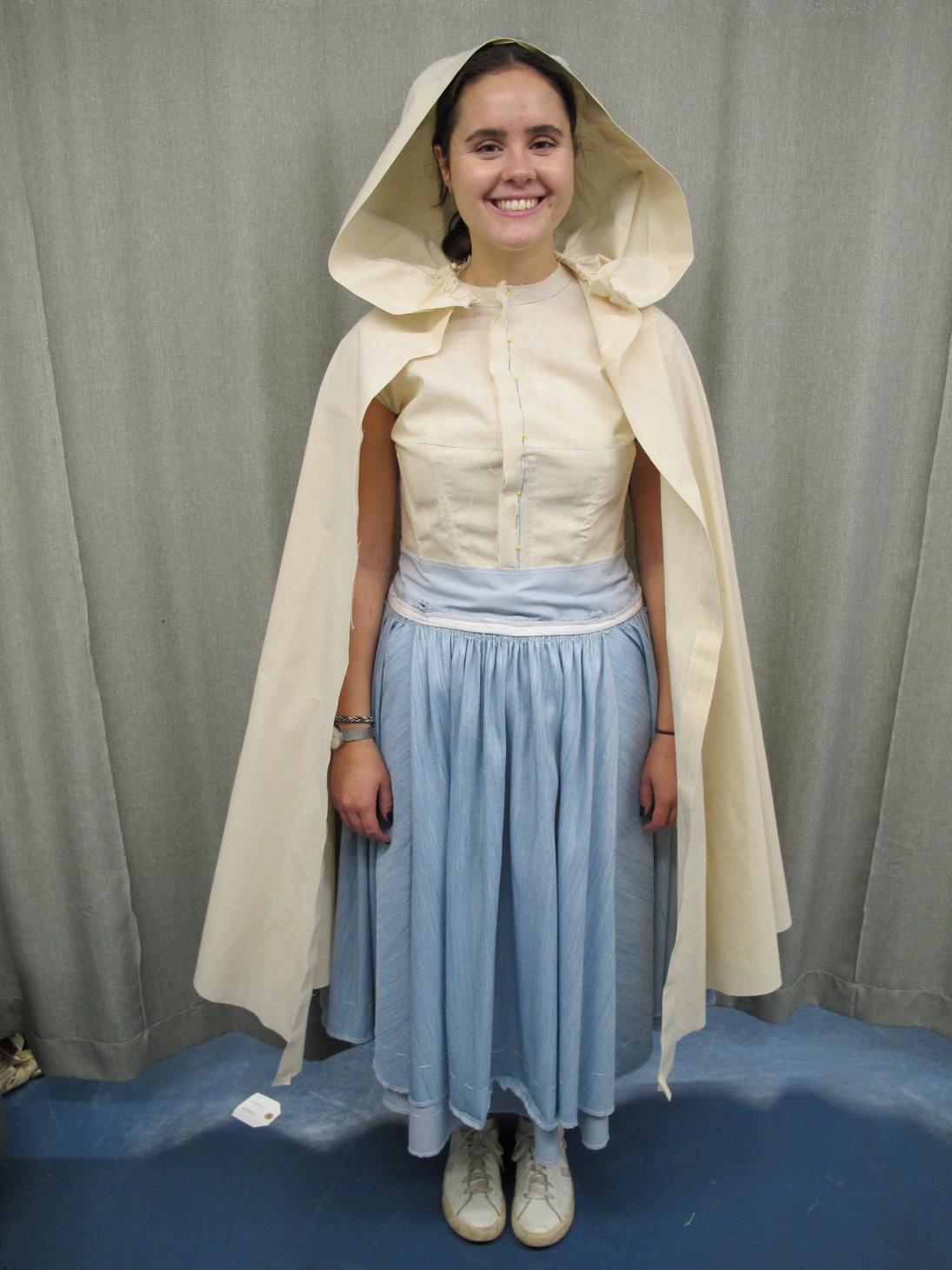

1st Fitting Photos


1st Fitting Photos


1st Fitting Photos


1st Fitting Photos




1st Fitting Notes
Actor
Lucy Hutchinson
Character Sylvia Maker Elsie Howards
Notes Breeches
- Elastic needs to be added to the bottom of the breeches so the bottom of the trouser leg needs to be 5cm wider
- Bring in the front of the waistband and adjust the front panel to the pinned lines
- Take in the back of the breeches at the waistband only, don’t go into the trouser
- Hem at the pins of the right trouser leg Bodice
- Take in at the CF
- Need a button stand 1.5cm left and right and add a 5cm SA
- Lower the top by 5cm
- Flare the side out at the hip to accentuate the waistline
- Take in the shoulder, not too much as can be done more in later fittings
- Move the armhole as pencilled
- Gather the top of the sleeve Skirt 1/PeLcoat
- Raise to above the knee as pinned
- Shorter yoke as pinned
- Need to add 2(- 4?) more panels to the skirt
- Gathered frills rather than pleated
- 3 full frills in light blue and the dark blue is used as a trim at the hem
- Frills need to be more than 3x the skirt and the same depth as Hannah’s frills
Topskirt
Raise the hem
Add the yoke as cut in calico
Cape
Make floorlength so next fitting hem can be curved
Cut the CF straight for next fitting
For armholes will need to make a hole that is faced
Add comb to hood so it can be pinned to hair
2nd Fitting Notes
Actor Lucy Hutchinson Character Sylvia Maker Elsie Howard Notes Breeches
• Add elastic and lace to the bottom of breeches
• Take in front seam near crotch straight Bodice
• Potential take in once we have bones in Sleeves
• Slash and spread sleeves
• Sleeve as pinned, new seam allowance where sleeve is folded(see ins)
• Added fullness Collar
• See drawn on collar for shape and size
• Same fabric
• Lace trim on edge Skirts
• Lengthen placket to same as top skirt and add frill
• Length of top skirt as pinned
• Match petticoat to same length of top skirt and add frill
• Confirm final length of skirts at next fitting
• White skirts, see pin of yolk of top skirt for width Shoes
• White shiny character shoes are good Cloak
• Lining similar to top of cloak
• Hem an inch above the floor at the back
• Curving off front of cloak
• Hook and bar for cloak
• Drop neckline to pin lines
• Dart on shoulder seam
• Pleat on front of neckline
• Add armhole where pins are
• Lining options needed for next fitting
2nd Fitting Photos


2nd Fitting Photos


2nd Fitting Photos


2nd Fitting Photos


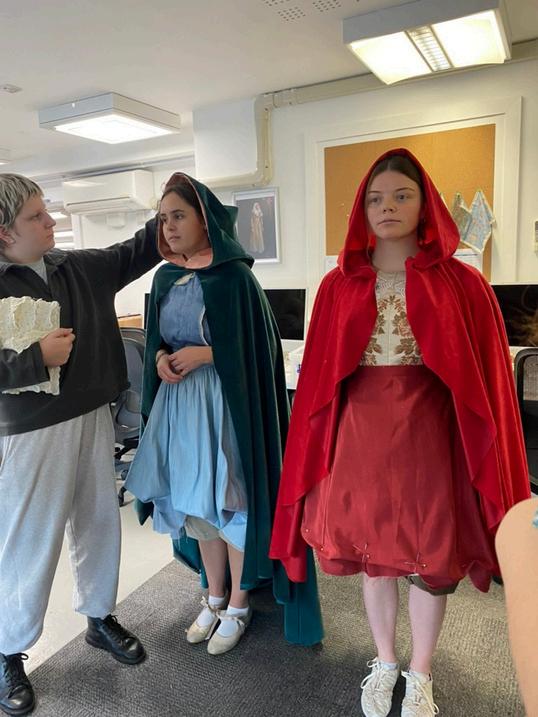

3rd Fitting Notes
Actor Lucy Hutchinson
Character
Sylvia Maker Elsie Howard Notes
-Add heel grips in the shoes
-Maybe add to sleeve head or add a gusset by the armhole
-Sleeve needs to be taken up at the hem where pinned
-Change the neckline to match the collar
-Isobel is happy with the buttons for the bodice
-Take hem up 2” above tack line on bottom petticoat
-Put more frill on the back than on the front, make it even


3rd Fitting Photos


3rd Fitting Photos


3rd Fitting Photos


Preassessment Notes
Actor Lucy Hutchinson Character Sylvia Maker Elsie Howard Notes Bodice:
• Front fastening – binding sits lower then finished edge (see pins)
• Steam collar – see pins (tacking may need to be moved)
• Gussets need to be inserted under arm
• Hook and bars on skirt and bodice to anchor bodice down
• Arm hole moved as pinned
• Shoulder taken in as pinned
• All bones need to be changed to spiral bones
• Try different underwear options
Dressing:
• Needs to wear skirt for orphanage
• When they are girls, breeches need to be above knee
• Bonnet like the orphans
White skirt:
• 2 inches bigger on waistband
Cape:
- Take up cape at the back – 2 inches up, do thorugh the dart in the shoulder
Blue waistcoat when dressed as a boy



Preassessment Pictures


Preassessment Pictures


Preassessment Pictures


Preassessment Pictures



Make Breakdown


Make Breakdown


Make Breakdown


Make Breakdown


Costume Breakdown


Costume Breakdown


Costume Breakdown


Actor: Jack Humphries Character: Mr Grimshaw
Measurement Sheet
Measurement Cheat Sheet
Costume Design
Fitting Photos
Fitting Notes
Make Breakdown
Costume Breakdown
Pictures From Measurements




Costume Design

1st Fitting Photos



1st Fitting Photos



1st Fitting Photos


1st Fitting Photos
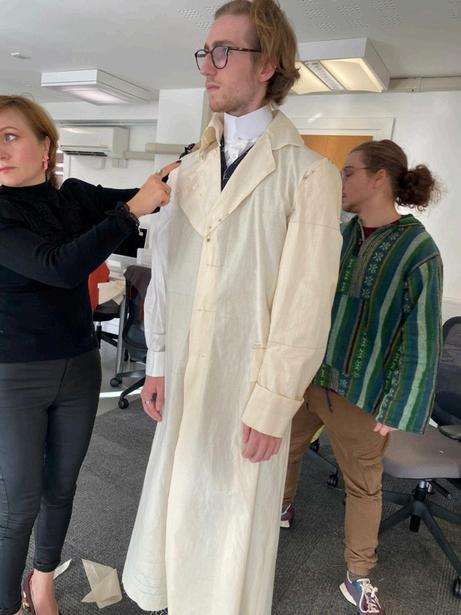



1st Fitting Notes
Actor Jack Humphry Character Mr Grimshaw Maker Charlie
Tolley
Notes
Trousers
The cuffs of the trousers where pinned. Take in where pinned.
Waistcoat
No alterations.
Shirt
Sleeves are too short they need to be longer. Look to see if the stiff collar can be slightly higher. Make a thin tie out of waistcoat fabric
Coat
Make the lapel bigger with calico added. Make the Collar higher and longer as seen with added Calico.
Bigger pockets as pinned on.
Make the cuff pointier, not in a straight line but scooped up
Raw edge finish length, need to add on SA
Two buttons on the band on back of coat
Buttons
Trousers will have flat buttons

2nd Fitting Notes
Actor
Jack Humphreys
Character Maker Mr Charlie Grimshaw Tolley
Notes
Trousers:
Let out the side seams gradually, as slightly too tight.
Waistcoat:
Make back as slim as possible: add darts on side back, make sure they don’t go higher than the chest line
Attach the strap higher than natural waist – take up to safety pin height.
Tie:
Make in black satin.
Greatcoat:
Coat is oversized – take in more with CB tab
Add in shoulder pads to make sleeve sit better. Pocket flaps, cuffs – line with braid Buttonholes – darker.
Lining – green (same as Tailoring unit)
Collar and lapels:
Adjust according to Kat’s pins. Lapels: keep original point, straighten line.
Source: Lingerless gloves. Maybe grey/knit/Lluffy to mimic wolves
Black satin Charlie’s neck tie
2nd Fitting Photos



2nd Fitting Photos



2nd Fitting Photos



2nd Fitting Photos




Preassessment Notes
Character Maker Mr Charlie Grimshaw. Tolley
Notes Shirt:
• •
Shoes: Source double cuff shirt Longer cuff
• Heel grips
• Find size 8/8.5 or 9 shoes
Jacket:
• Steam collar



Pre-assessment Photos



Make Breakdown


Make Breakdown


Make Breakdown

Costume Breakdown




Costume Breakdown

Costume Breakdown


Actor: Cal Campbell Character: Train Conductor
Measurement Sheet
Measurement Cheat Sheet
Costume Design
Fitting Photos
Fitting Notes
Costume Breakdown
Pictures From Measurements






1st Fitting Photos
Train Conductor



1st Fitting Photos
Wolves/ Chorus



1st Fitting Notes
Actor Cal campbell Notes Breeches:
Character Train Inspector Maker Sourced
• Need to be taken in
Shoes:
• Get insoles
Pre-assessment Notes
Actor Cal campbell Character Chorus Maker sourced
• Need to be taken in at back
Shoes:
• Smaller shoes
• Dark red laces
Wolf: Notes Breeches:
• Still loose
• See pins
Find 5 5 boots as a back up
Train conductor:
• Tack badge in place
• Pins may need adapting
Pre-assessment Photos
Train Conductor



Pre-assessment Photos

Chorus


Pre-assessment Photos
Wolves/ Chorus



Orphan



Costume Breakdown



Costume Breakdown

Costume Breakdown

Costume Breakdown






Actor: David Isherwood Character:
Mr
Willoughby
Measurement Sheet
Measurement Cheat Sheet
Costume Design
Fitting Photos
Fitting Notes
Make Breakdown
Costume Breakdown
Pictures From Measurements




Costume Design

1st Fitting Photos


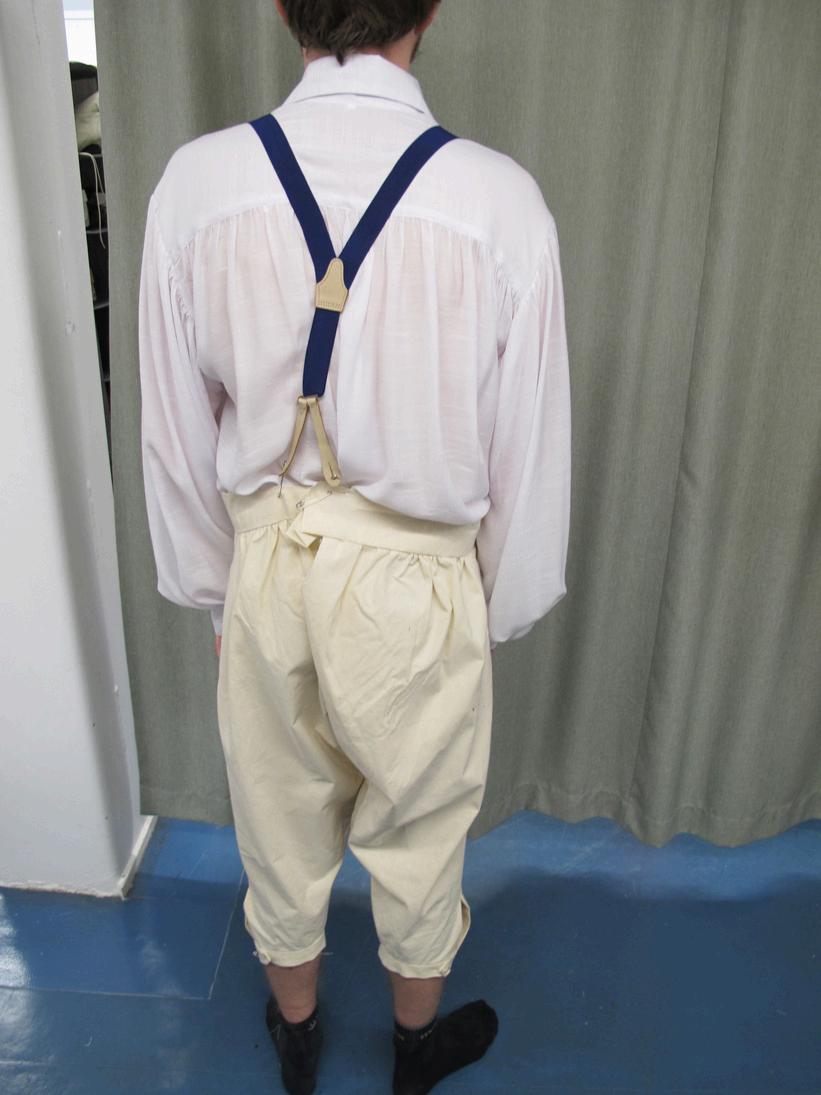

1st Fitting Photos



1st Fitting Photos




1st Fitting Notes
Actor David Isherwood
Maker Grace McGorty
Character Mr Willoughby Notes Breeches
• Tighter at the waist, don’t cut the fabric.
• Add 10 cm on each side, and draw straights down to make more puffy.
• Make cuffs tighter where pinned.
Waistcoat
• Collar needs to be adjusted and shorten as pinned
• Move shoulder line back to where marked
• Shorten the collar at the back
• Add cotton wadding into the chest where marked to fill out the chest more
Coat
• Lengthen at the hemline as pinned
• New armhole where pinned
• Head of sleeve needs to be 3 cm bigger
• cuff needs to be 3D.
• Collar as made out of calico.
• Buttons



2nd Fitting Notes
Actor David Isherwood
Character
Mr Willoughby
Maker Grace McGorty
• 8cm(ish) too small
• Front flap – make tighter.
• Side seams moved forward to safety pin mark.
• Taper breeches – keep fullness at hem, but taper towards the waist to reduce fullness. Tapers to nothing at hem.
• Bow on breeches out of Sophie’s ribbon.
Waistcoat:
• (Do up left on top of right)
• Lower neckline at the back, to stop bunching
• Make neckline lower all round, following Kat’s pinned line.
• Make a sharper lapel point
• NOTE: add a cravat (used frilly one from mannequin in fi[ng).
Coat:
• Let out a little bit at the back.
• Tight at front of underarm: has been cut into and released.
• Collar is higher at the back
• Not sure on the grey trim along coat edge, maybe just cuffs or nothing at all
Sleeves of coat:
• Let out 1.5cm from sleeves, taper out to elbow.
• Add a bow on the cuff.
Bows:
• One layer, maybe made from bias binding, in a silky material Lighter weight fabric
• First bow is better.
NOTE:
• Supervisors: buy stockings: blush or white
• Shoes are too wide, look for more insoles?
• Notes Breeches:
2nd Fitting Photos


2nd Fitting Photos
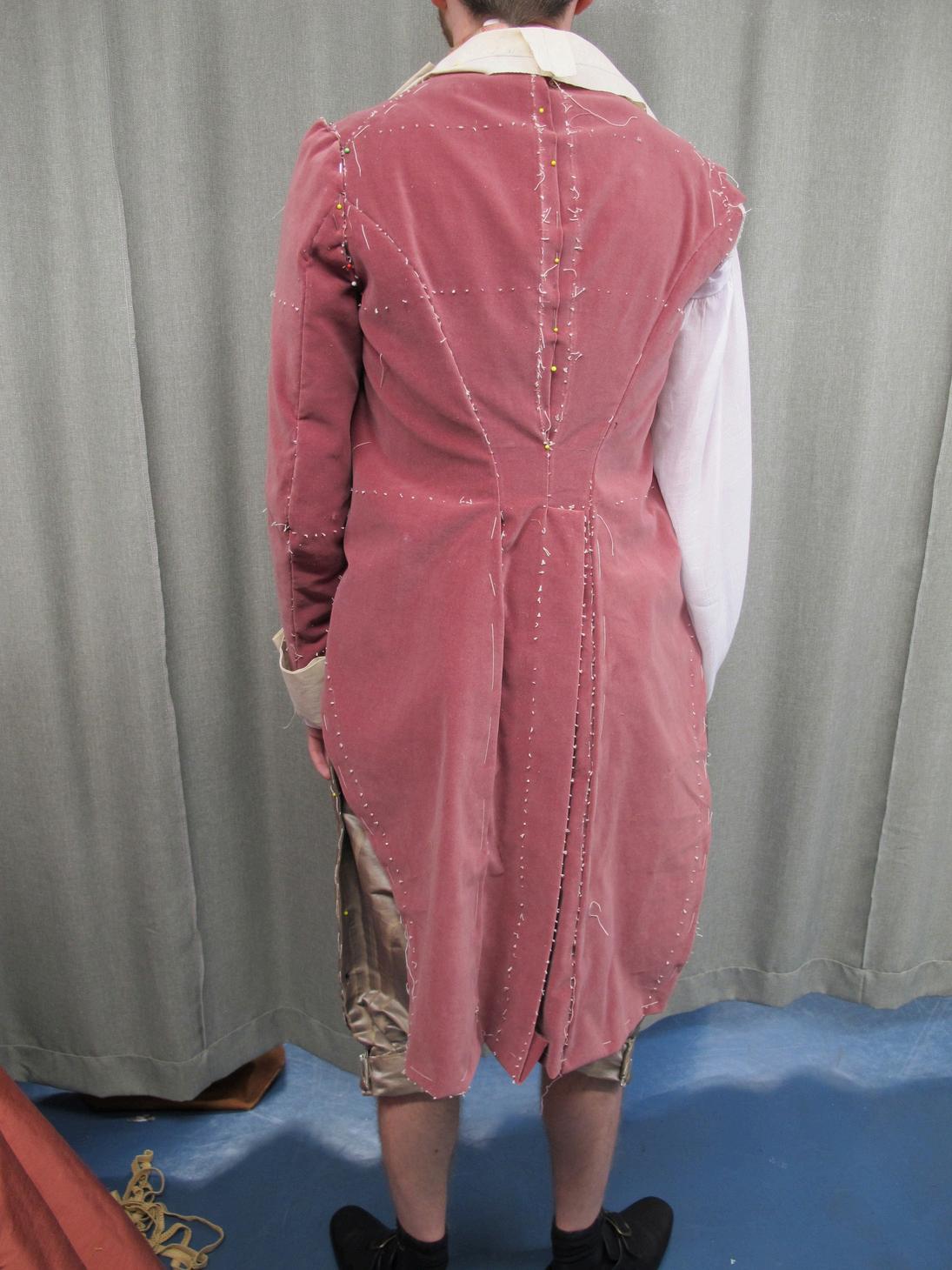

2nd Fitting Photos


2nd Fitting Photos




Pre-assessment Photos


*No Pre-assessment Notes

Make Breakdown


Make Breakdown


Make Breakdown





Actor: David Isherwood Character: Simon
Measurement Sheet
Measurement Cheat Sheet
Costume Design
Fitting Photos
Fitting Notes
Make Breakdown
Costume Breakdown
Pictures From Measurements




Costume Design

1st Fitting Photos



1st Fitting Photos



1st Fitting Photos




1st Fitting Notes
Actor David Isherwood
Character Simon Maker Jenny Bawden
Notes Breeches
• Make smaller at the back where it was pinned.
• Add 15cm on each side and make it straight Shirt
• Have the collar for the next fitting
• Have the cuff for the next fitting
• Cuffs of sleeve are where pinned Coat
• Jacket needs to be lined.
• Shorten jacket to where pinned and copy the curve that was originally there
• Collar as is on the jacket
• make the armhole slightly bigger by to where pinned
• lengthen the sleeves to where taken out.
• cuff goes where marked.
• need cuff for next fitting.
• double pleat on the bottom of the pocket and fold over at the top
• strip of the fabric and add embroidery on the wrong side sample be made first with straight edge, scalloped edge.
• Embroidery the same colours/ tone as the wool.
Buttons
• Wooden toggles for the coat
2nd Fitting Notes
Actor David Isherwood
Character Simon Maker Jenny Bawden
Notes Breeches:
• Men’s fastening to the left
• Button holes need to one in the centre and then one slightly off to the side
• Look into under garment as breeches are itchy Coat:
• Collar is pinned to where it needs to be adjusted
• Sleeve seems to fit well
• Making pom poms out of the wool, or use the pom pom trim either one.
• Cuff is all good
• SUPERVISOR NOTE
• Buy leather garterflaps
2nd Fitting Photos


2nd Fitting Photos


2nd Fitting Photos


2nd Fitting Photos


2nd Fitting Photos




Preassessment Notes
Actor David Isherwood
Character Simon Maker Jenny Bawden
• •
Shirt:
• Notes Buttonholes on CF Layer chuncky socks Can cut off toes and layer over shoes



Pre-assessment Photos
Chorus



Pre-assessment Photos
Chorus/ Wolf



Make Breakdown



Make Breakdown



Make Breakdown

Costume Breakdown









Costume Breakdown



Actor: Jennifer Saunders
Character: Mrs
Willoughby
Measurement Sheet
Measurement Cheat Sheet
Costume Design
Fitting Photos
Fitting Notes
Make Breakdown
Costume Breakdown
Pictures From Measurements




Costume Design

1st Fitting Photos


1st Fitting Photos


1st Fitting Photos



1st Fitting Photos




1st Fitting Notes
Actor Jennifer Saunders Character Mrs Willoughby
Maker
Sophie Diosi
Notes Petticoat
- Maybe release the skirt unless the corset is tighter Bodice
- Take in at the CB
- Take in the bust seam
- Follow the shoulder on the right side of the body
- Back boning take in as pinned
- New waist and bust line as marked
- Neckline as marked Sleeve
- Slit at the wrist with button and elastic for QC
- Take in the sleeve puff as pinned
- Take in the sleeve along the forearm and hem as pinned
- Back the sleeve with net for structure Skirt
- Repleat to recentre the front pleats and distance from side
seams Supervisor: Lace for next fitting as trimming for the
neckline: Need gold metallic lace/ braiding trim
Insole needed
2nd Fitting Notes
Character Mrs Willoughby
Maker
Actor Jennifer Saunders Notes
Sophie Diosi
Petticoat
• Waistband let out 1.5 inches Bodice
• Let out 1 cm either side of the centre back
• Narrow on bias 1 cm pleats angling to centre front Sleeve
• See pins on cuff
• Order nett for sleeve Collar
• Box pleats in pink taffeta 1 5cm wider
• No magenta
• Narrow lace to edge, neckline white
• Source chiffon Skirt
• Bow same colour as skirt fabric
2nd Fitting Photos


2nd Fitting Photos


2nd Fitting Photos


2nd Fitting Photos




Preassessment Notes
Actor Jennifer Saunders
Character
Mrs Willoughby Maker Sophie Diosi
Notes
Petticoat:
- Move bar on waist as pinned
- Make sure corners of bows are attached to skirt
- Stabstitch down fastenings on CB
- Gold on the bows
- Find a small gold trim to put in centre of the trim around the neckline
- Put another petticoat underneath – NOT MADE



Make Breakdown

Make Breakdown

Make Breakdown


Costume Breakdown

Costume Breakdown


Actor: Jennifer Saunders
Character: School Inspector
Measurement Sheet
Measurement Cheat Sheet
Costume Design
Fitting Photos
Fitting Notes
Make Breakdown
Costume Breakdown
Pictures From Measurements







1st Fitting Photos


1st Fitting Photos



1st Fitting Notes
Actor Jennifer Saunders Character School Inspector Maker Bella Davis Notes Jacket
Let the jacket out 1” at the back side slits as pinned
Hem as pinned
Straps attached as pinned
Redo the collar pattern as done in calico
Attach collar as pinned
Add pocket with pleat (bellows pocket)
Add 3cm to the sleeve head
Need a cuff opening at the sleeve add 3 small buttons at the cuff
2nd Fitting Notes
Actor Jennifer Saunders Character School Inspector Maker Bella Davis Notes Shirt
• Make shorter in body and sleeve length
• More button as pinned on sleeve cuff
• Try shoes on next week Breeches
• All good
• Smaller Braces Jacket
• Move button stand
• CF is now button stand
• Back seams is changed to where pinned
• Add shoulder pads
• Add 1 5cm to seam cuff and 5cm to seam allowance just in case
• Move concealed pleat over as pinned
• Pocket as pinned
• Two button holes on belt 5-6cm apart with safety pin
• Ask Ellie is she has enough grey pinstripe for cravat
• Ask Seren for buttons
2nd Fitting Photos



Preassessment Notes
Actor Jennifer Saunders Character School Inspector Maker Bella Davis Notes Breeches:
• Need buttonholes
Shirt:
• Add another button on shirt cuff – see pins Hat:
• Padding in bowler (3 insoles wide) Jacket:
• Slightly tight round shoulder – may need loosening depending on movement required
• Sleeve has not been set in straight – need to re-set (see pins in left and mirror on right)
• Lengthen cuff
Chorus
• Talk to Kat about button placement because they are not in right place



Pre-assessment Photos



Pre-assessment Photos
School Inspector
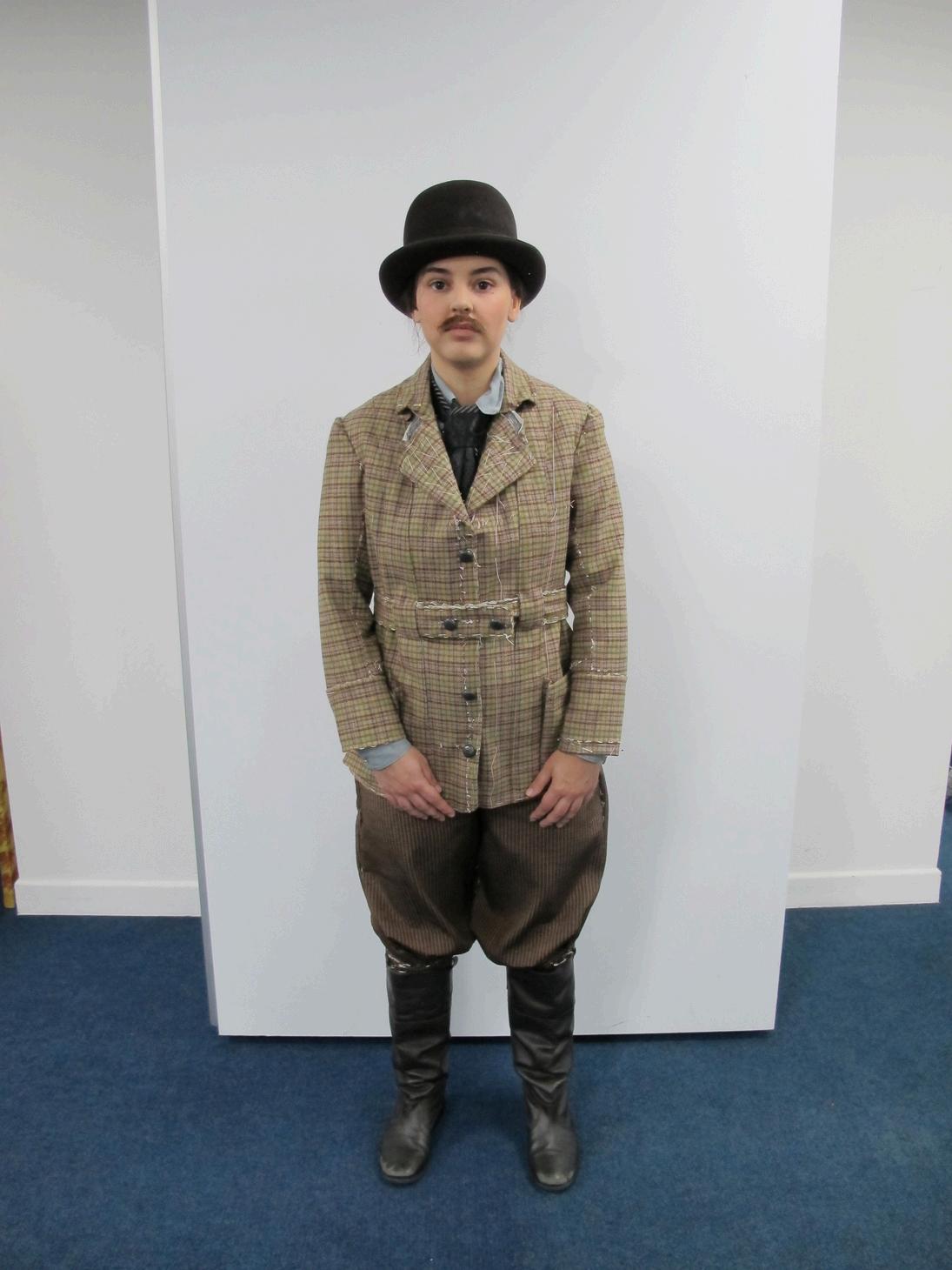


Make Breakdown


Make Breakdown


Costume Breakdown


Costume Breakdown



Costume Breakdown

Costume Breakdown


Costume Breakdown


Suppliers Sheet
Supplier
Arts University Bournemouth
Phone
Haberdashery Store - 7 Fern Barrow, Wallisdown, Poole BH12 5HH
Jones Buttons
Marks and Spencers
0115 973 8708 Lortas Rd, Nottingham NG5 1EH
01202 363600 Yeomans Way, Bournemouth BH8 9UL
Vinted
Fabric Land
01202 580066 3 Dominion Rd, West Howe Industrial Estate, Bournemouth BH11 8LH
Darcy
A to Z Fabrics
H and M
Fabrix
Orya
Universal Textiles
Hobby Craft
Toni Textiles
UK Textiles
01273 471586 The Maltings, Castle Precincts, Lewes BN7 1YT
020 8222 6566 53A Goldhawk Rd, London W12 8QP
0344 736 9000
07944 848 982
020 8746 1683
020 8743 4154
Unit M, West Mall Castlepoint, Castle Ln W, Bournemouth BH8 9UY
26A Goldhawk Road, Shepherd's Bush, London, W12 8DH
Goldhawk Rd, London W12 8DH
Goldhawk Rd, London W12 8QQ
0330 026 1020 Longham, Bournemouth, Ferndown BH22 9DJ
020 8743 1488
Goldhawk Rd, London W12 8QP
020 8749 4077 45b, 47 Goldhawk Rd, London W12 8QP Fabric World
020 8740 0102
Goldhawk Rd, London W12 8QP
Costume Breakdown
I purchased the Chorus shirt from Amazon It's a polyester pirate fancy dress shirt. I chose this style because I felt it represented the dress trend of the 1830s, which featured gathered shoulder seams that continued onto the bodice or sleeve This trend was particularly popular in women's wear, so I made sure to represent it in the Chorus shirts
As a group, we all participated in breaking down these shirts and tried different methods The first method involved trying to batik wax onto the shirts that Amelia and Rosie had previously dyed. This was a very tedious process Amelia and I did half a shirt each, and it took three hours. Our method of painting looked completely different, so we didn't end up doing it
As a group, we decided to dye the shirts collectively. We first wet the shirts and squeezed out the excess water, and then submerged them in a mixed dye that Rosie made for a minute. After that, we took the shirts out of the dye and rinsed them again We repeated these steps for all the shirts and ensured that they all had a similar color.
Batik Experiment
Isobel suggested creating a tree effect by using a mixture of water and flour to make a paste, which we could then crack and paint between However, when we came back after doing this, three of the shirts had become solid. It took Rosie and me days to scrub the flour out

We ended up using stencils that Isobel had made, and we applied the paint onto the shirts using a sponge. Rosie arranged for the CPD students from levels 4 and 5 to come and help us, while Amelia, Rosie, Isobel, and I worked on the remaining shirts. To avoid similar issues in the future, I plan to work on breakdowns at the beginning of the term, along with providing samples



Process Pictures

London Fabric Shopping



Process Pictures

3rd Fitting and Pre-Assessment



Process Pictures

Dress Rehearsal



Process Pictures
Show Week

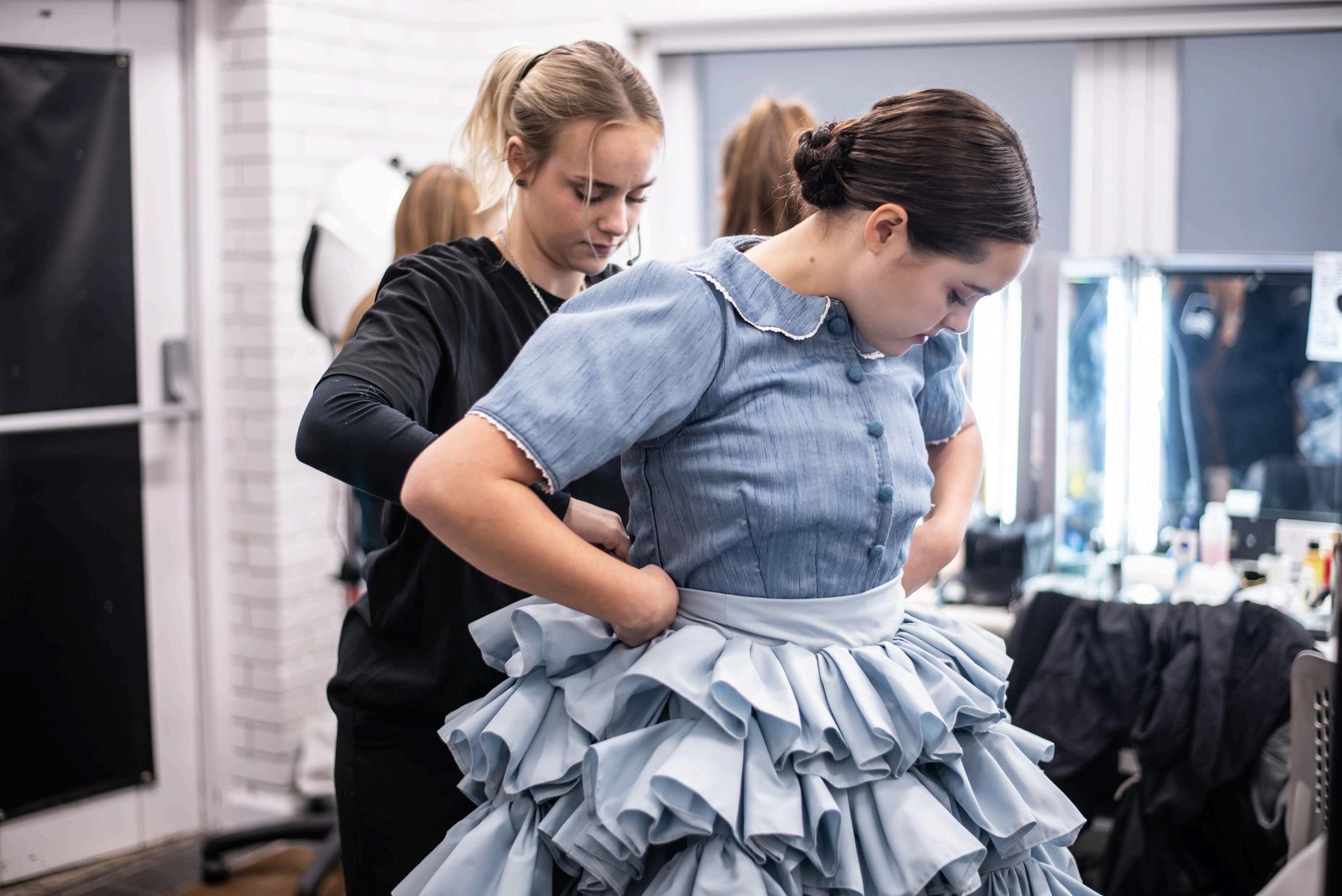


Process Pictures

Show Week



Process Pictures

Show Week



Process Pictures

Show Week



CPD Hours- Spring Awakening
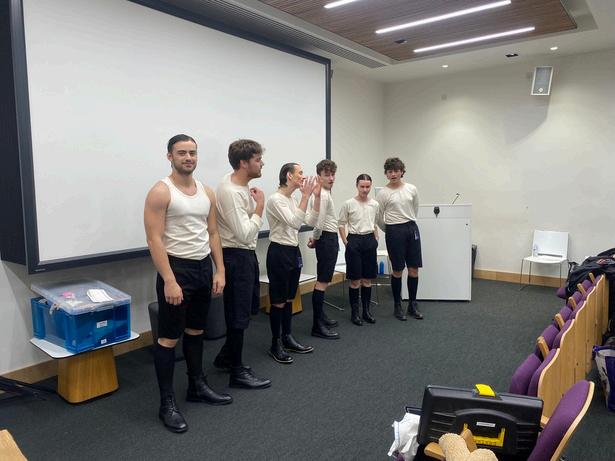



Dresser and Photographer for Spring Awakening PreAssessment





Note Taker for Macbeth PreAssessment






Note Taker and Photographer for Thérése Fitting CPD Hours- Thérése





Figures List
Fig 1
Cartwright, M. (2023) The textile industry in the British Industrial Revolution, World History Encyclopedia. Available at: https://www.worldhistory.org/article/2183/the-textile-industry-in-the-british-industrial-rev/ (Accessed: 10 October 2023).
Fig 2
William IV (2023) Wikipedia. Available at: https://en.wikipedia.org/wiki/William_IV (Accessed: 10 October 2023).
Fig 3
George IV’s bills (2020) Georgian Papers Programme. Available at: https://georgianpapers.com/explore-thecollections/collections/george-iv/george-ivs-bills/ (Accessed: 10 October 2023).
fig 4
Facebook (no date) Facebook. Available at: https://www.facebook.com/photo? fbid=249798937033&set=ms.c.eJxNy7ENADAIA7CPKkQCgf8fq1Q6MHqws9XVkAHHB9yIjfQFDQJIEh8sq3znAky2Em4~-.bps.a.249792837 033 (Accessed: 10 October 2023).
Fig 5
Facebook (no date) Facebook. Available at: https://www.facebook.com/photo? fbid=249798937033&set=ms.c.eJxNy7ENADAIA7CPKkQCgf8fq1Q6MHqws9XVkAHHB9yIjfQFDQJIEh8sq3znAky2Em4~-.bps.a.249792837 033 (Accessed: 10 October 2023).
Fig 6
The wolves of Willoughby Chase (1989) IMDb. Available at: https://www.imdb.com/title/tt0096459/ (Accessed: 10 November 2023).
Fig 7
The wolves of Willoughby Chase (1989) IMDb. Available at: https://www.imdb.com/title/tt0096459/ (Accessed: 10 November 2023).
Fig 8
The wolves of Willoughby Chase (1989) IMDb. Available at: https://www.imdb.com/title/tt0096459/ (Accessed: 10 November 2023).
Fig9
The wolves of Willoughby Chase (1989) IMDb. Available at: https://www.imdb.com/title/tt0096459/ (Accessed: 10 November 2023).
Fig 10,11,12,13
The Wolves of Willoughby Chase [DVD] (no date).
Fig 14, 15, 16, Images Taken by Myself
Fig 17
Chemise: American or European (1970) The Metropolitan Museum of Art. Available at: https://www.metmuseum.org/art/collection/search/82061 (Accessed: 08 November 2023).
Fig 18
RP1830B - 1830’s stays pattern pack B (18-26 plus) (2023) Renaissance Fabrics. Available at: https://renaissancefabrics.net/product/1830s-stays-pattern-pack-b-18-26-plus/ (Accessed: 08 November 2023).
Fig 19
Picture Taken By Myself
Fig 20
Corsets, crinolines and bustles: Fashionable victorian underwear · V&A (no date) Victoria and Albert Museum. Available at: https://www.vam.ac.uk/articles/corsets-crinolines-and-bustles-fashionable-victorian-underwear (Accessed: 08 November 2023).
Fig 21
Picture Taken by Myself
Fig 22
Picture Taken by Myself
Fig 23
Corsets, crinolines and bustles: Fashionable victorian underwear · V&A (no date) Victoria and Albert Museum. Available at: https://www.vam.ac.uk/articles/corsets-crinolines-and-bustles-fashionable-victorian-underwear (Accessed: 08 November 2023).
Fig 24
Picture Taken by Myself
Fig 25
Boys clothes: 1830s (no date) boys clothes: 1830s. Available at: https://histclo.com/chron/c1830.html (Accessed: 10 November 2023).
Fig 26 24, P.T.A. et al. (2021) The Writer’s Guide to 1830s men’s fashion, Rebecca Shedd - Author. Available at: https://rebeccashedd.com/2021/06/25/the-writers-guide-to-1830s-mens-fashion/ (Accessed: 08 November 2023).
Fig 27
24, P.T.A. et al. (2021) The Writer’s Guide to 1830s men’s fashion, Rebecca Shedd - Author. Available at: https://rebeccashedd.com/2021/06/25/the-writers-guide-to-1830s-mens-fashion/ (Accessed: 08 November 2023).
Figures List
Fig 28
24, P.T.A. et al. (2021) The Writer’s Guide to 1830s men’s fashion, Rebecca Shedd - Author. Available at: https://rebeccashedd.com/2021/06/25/the-writers-guide-to-1830s-mens-fashion/ (Accessed: 08 November 2023).
Fig 29
24, P.T.A. et al. (2021) The Writer’s Guide to 1830s men’s fashion, Rebecca Shedd - Author. Available at: https://rebeccashedd.com/2021/06/25/the-writers-guide-to-1830s-mens-fashion/ (Accessed: 08 November 2023).
Fig 30
Facebook (no date) Facebook. Available at: https://www.facebook.com/photo?
fbid=249798937033&set=ms.c.eJxNy7ENADAIA7CPKkQCgf8fq1Q6MHqws9XVkAHHB9yIjfQFDQJIEh8sq3znAky2Em4~-.bps.a.2497 92837033 (Accessed: 10 October 2023).
Fig 31
Facebook (no date) Facebook. Available at: https://www.facebook.com/photo?
fbid=249798937033&set=ms.c.eJxNy7ENADAIA7CPKkQCgf8fq1Q6MHqws9XVkAHHB9yIjfQFDQJIEh8sq3znAky2Em4~-.bps.a.2497 92837033 (Accessed: 10 October 2023).
fig 32
24, P.T.A. et al. (2021) The Writer’s Guide to 1830s men’s fashion, Rebecca Shedd - Author. Available at: https://rebeccashedd.com/2021/06/25/the-writers-guide-to-1830s-mens-fashion/ (Accessed: 08 November 2023).
Fig 33
Museum, V. and A. (no date) Pair of shoes: Unknown: V&A explore the collections, Victoria and Albert Museum: Explore the Collections. Available at: https://collections.vam.ac.uk/item/O117716/pair-of-shoes-unknown/ (Accessed: 08 November 2023).
Fig 34
24, P.T.A. et al. (2021) The Writer’s Guide to 1830s men’s fashion, Rebecca Shedd - Author. Available at: https://rebeccashedd.com/2021/06/25/the-writers-guide-to-1830s-mens-fashion/ (Accessed: 08 November 2023).
Fig 35
Virago (no date) Men’s fashion ca. 1830: Accessories, VIRAGO. Available at: https://ellievalsin.tumblr.com/post/129716351246/mens-fashion-ca-1830-accessories (Accessed: 08 November 2023).
Reference List
Www.silktophats.eu (no date) History of the top hat | Silk Top Hats .eu. Available at: https://www.silktophats.eu/historytophat.html (Accessed: 10 October 2023).
Pride, R. (2019) The costume supervisor’s toolkit: Supervising theatre costume production from first meeting to final performance. New York; London: Routledge.
Tunney, R. and Aiken, J. (2013) The wolves of Willoughby Chase. London: Nick Hern Books.
The Wolves of Willoughby Chase [DVD] (no date).
Cole, S. and Miles, L. (2021) Dandy style: 250 years of British Men’s Fashion. New Haven: Yale University Press.
EDWARDS, L. (2015) How to read a dress. BLOOMSBURY ACADEMIC.
Edwards, L. (2021) How to read a suit a guide to changing men’s fashion from the 17th to the 20th century. London: Bloomsbury Visual Arts.
Rose, C. (1990) Children’s clothes: Since 1750. London: Batsford.
James II (r.1685-1688) (no date) The Royal Family. Available at: https://www.royal.uk/james-ii (Accessed: 10 October 2023).
Museum, K.D.H. (2022) Artifact corner: 1830’s Women’s Shoes, Kent Delord House Museum - A historic museum in Plattsburgh, New York. Available at: https://www.kentdelordhouse.org/artifact-corner-1830s-womensshoes/#:~:text=Gone%20were%20the%20heeled%20shoes,made%20on%20a%20straight%20last. (Accessed: 10 October 2023).
Museum, V. and A. (no date) Pair of shoes: Unknown: V&A explore the collections, Victoria and Albert Museum: Explore the Collections. Available at: https://collections.vam.ac.uk/item/O117716/pair-of-shoes-unknown/ https://fashionhistory.fitnyc.edu/1830-1839/ (Accessed: 10 October 2023).
Silhouettes (2018) By 1840, the collapsed sleeve was..., Silhouettes Costumes. Available at: https://silhouettescostumes.com/by-1840-the-collapsed-sleeve-was/ (Accessed: 10 October 2023).
William IV: The maddest lad to ever sit on the British Throne (2023) YouTube. Available at: https://youtu.be/uxOFnQFcHKQ?si=LkDiPFIwdyQWBDcn (Accessed: 10 October 2023).
The wolves of Willoughby Chase (no date) TV Tropes. Available at: https://tvtropes.org/pmwiki/pmwiki.php/Literature/TheWolvesOfWilloughbyChase (Accessed: 10 October 2023).
Bibliography
(No date a) The 1833 factory act - UK parliament. Available at: https://www.parliament.uk/about/livingheritage/transformingsociety/livinglearning/19thcentury/overview/factoryact/ (Accessed: 10 October 2023).
(No date b) Living heritage - UK parliament. Available at: https://www.parliament.uk/about/living-heritage/ (Accessed: 10 October 2023).
1830-1839 (2020) Fashion History Timeline. Available at: https://fashionhistory.fitnyc.edu/1830-1839/ (Accessed: 10 October 2023).
The 1830s in fashionable gowns: A visual guide to the decade (2021) Mimi Matthews. Available at: https://www.mimimatthews.com/2015/11/30/the-1830s-in-fashionable-gowns-a-visual-guide-to-the-decade/ (Accessed: 10 October 2023).
24, P.T.A. et al. (2021a) The Writer’s Guide to 1830s men’s fashion, Rebecca Shedd - Author. Available at: https://rebeccashedd.com/2021/06/25/the-writers-guide-to-1830s-mens-fashion/ (Accessed: 10 October 2023).
24, P.T.A. et al. (2021b) The Writer’s Guide to 1830s men’s fashion, Rebecca Shedd - Author. Available at: https://rebeccashedd.com/2021/06/25/the-writers-guide-to-1830s-mens-fashion/ (Accessed: 10 October 2023).
Boys clothes: 1830s (no date) boys clothes: 1830s. Available at: https://histclo.com/chron/c1830.html (Accessed: 10 October 2023).
History - james II (no date) BBC. Available at: https://www.bbc.co.uk/history/historic_figures/james_ii.shtml (Accessed: 10 October 2023).
James II (r.1685-1688) (no date) The Royal Family. Available at: https://www.royal.uk/james-ii (Accessed: 10 October 2023).
Museum, K.D.H. (2022) Artifact corner: 1830’s Women’s Shoes, Kent Delord House Museum - A historic museum in Plattsburgh, New York. Available at: https://www.kentdelordhouse.org/artifact-corner-1830s-womensshoes/#:~:text=Gone%20were%20the%20heeled%20shoes,made%20on%20a%20straight%20last. (Accessed: 10 October 2023).
Museum, V. and A. (no date) Pair of shoes: Unknown: V&A explore the collections, Victoria and Albert Museum: Explore the Collections. Available at: https://collections.vam.ac.uk/item/O117716/pair-of-shoes-unknown/ https://fashionhistory.fitnyc.edu/1830-1839/ (Accessed: 10 October 2023).
Silhouettes (2018) By 1840, the collapsed sleeve was..., Silhouettes Costumes. Available at: https://silhouettescostumes.com/by-1840-the-collapsed-sleeve-was/ (Accessed: 10 October 2023).
William IV: The maddest lad to ever sit on the British Throne (2023) YouTube. Available at: https://youtu.be/uxOFnQFcHKQ?si=LkDiPFIwdyQWBDcn (Accessed: 10 October 2023).
The wolves of Willoughby Chase (no date) TV Tropes. Available at: https://tvtropes.org/pmwiki/pmwiki.php/Literature/TheWolvesOfWilloughbyChase (Accessed: 10 October 2023).
Bibliography
Www.silktophats.eu (no date) History of the top hat | Silk Top Hats .eu. Available at: https://www.silktophats.eu/historytophat.html (Accessed: 10 October 2023).
Pride, R. (2019) The costume supervisor’s toolkit: Supervising theatre costume production from first meeting to final performance. New York; London: Routledge.
Tunney, R. and Aiken, J. (2013) The wolves of Willoughby Chase. London: Nick Hern Books.
The Wolves of Willoughby Chase [DVD] (no date).
Cole, S. and Miles, L. (2021) Dandy style: 250 years of British Men’s Fashion. New Haven: Yale University Press.
EDWARDS, L. (2015) How to read a dress. BLOOMSBURY ACADEMIC.
Edwards, L. (2021) How to read a suit a guide to changing men’s fashion from the 17th to the 20th century. London: Bloomsbury Visual Arts.
Rose, C. (1990) Children’s clothes: Since 1750. London: Batsford.
